Analysis of Healthcare Finance in Australia, UK, and US
VerifiedAdded on 2022/11/13
|10
|2315
|164
Report
AI Summary
This report provides a comparative analysis of healthcare finance and management in Australia, the UK, and the US, focusing on data from the OECD. It examines the financial expenditure, key performance indicators like hospital length of stay, and the impact of policies such as the Pharmaceutical Benefits Scheme (PBS) in Australia and the Affordable Care Act (ACA) in the US. The report highlights Australia's lower hospital stay duration compared to the UK and US, but also addresses the increasing healthcare costs and the impact of obesity trends. It explores the roles of governmental and non-governmental organizations in healthcare funding across these countries. The report also discusses the challenges in the Australian healthcare system including resource allocation and health inequality, and concludes with recommendations for interdisciplinary research and policy implementation to improve healthcare outcomes and financial performance. The report is a valuable resource for students studying healthcare finance and policy, offering insights into the complexities of global healthcare systems.
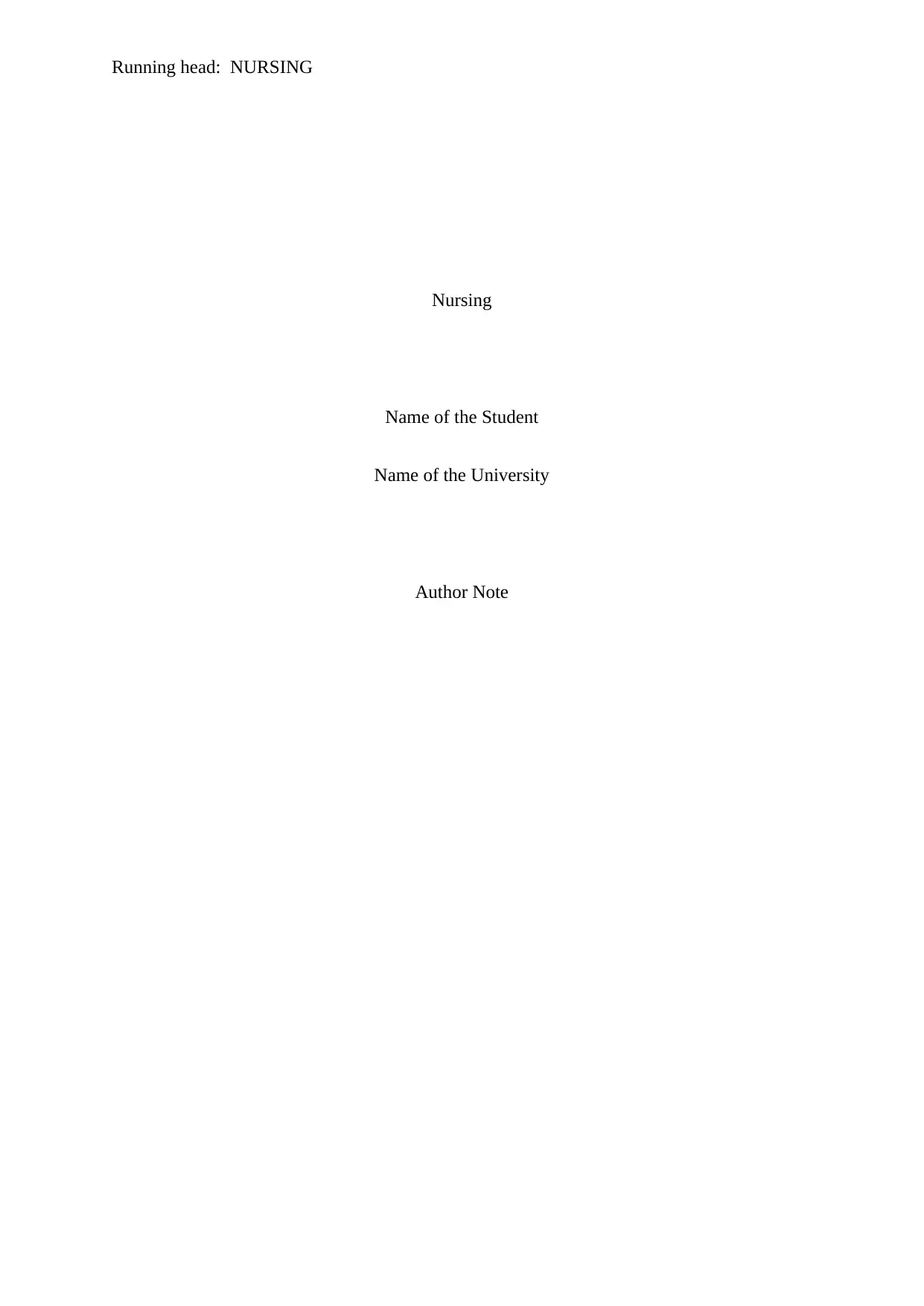
Running head: NURSING
Nursing
Name of the Student
Name of the University
Author Note
Nursing
Name of the Student
Name of the University
Author Note
Paraphrase This Document
Need a fresh take? Get an instant paraphrase of this document with our AI Paraphraser
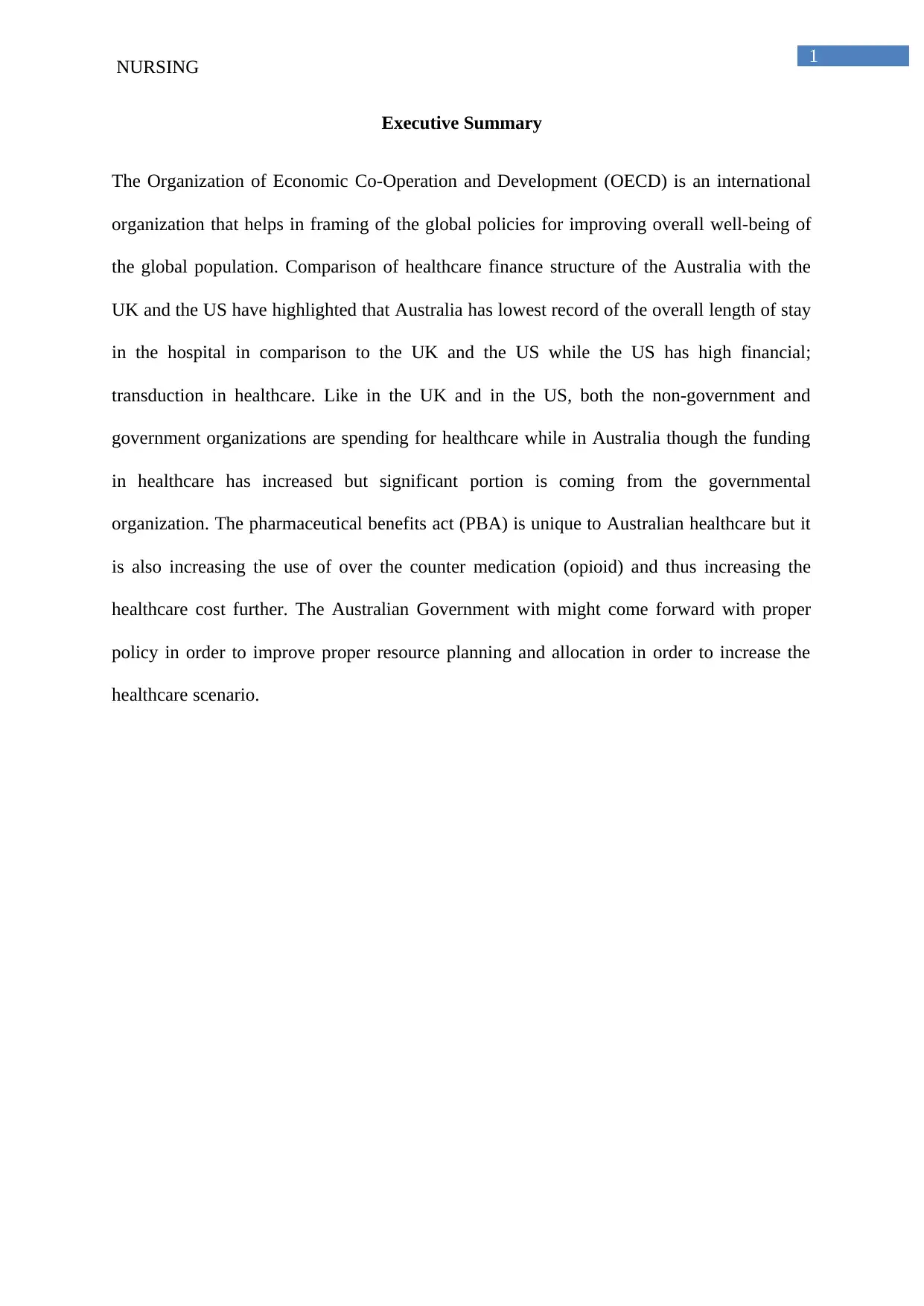
1
NURSING
Executive Summary
The Organization of Economic Co-Operation and Development (OECD) is an international
organization that helps in framing of the global policies for improving overall well-being of
the global population. Comparison of healthcare finance structure of the Australia with the
UK and the US have highlighted that Australia has lowest record of the overall length of stay
in the hospital in comparison to the UK and the US while the US has high financial;
transduction in healthcare. Like in the UK and in the US, both the non-government and
government organizations are spending for healthcare while in Australia though the funding
in healthcare has increased but significant portion is coming from the governmental
organization. The pharmaceutical benefits act (PBA) is unique to Australian healthcare but it
is also increasing the use of over the counter medication (opioid) and thus increasing the
healthcare cost further. The Australian Government with might come forward with proper
policy in order to improve proper resource planning and allocation in order to increase the
healthcare scenario.
NURSING
Executive Summary
The Organization of Economic Co-Operation and Development (OECD) is an international
organization that helps in framing of the global policies for improving overall well-being of
the global population. Comparison of healthcare finance structure of the Australia with the
UK and the US have highlighted that Australia has lowest record of the overall length of stay
in the hospital in comparison to the UK and the US while the US has high financial;
transduction in healthcare. Like in the UK and in the US, both the non-government and
government organizations are spending for healthcare while in Australia though the funding
in healthcare has increased but significant portion is coming from the governmental
organization. The pharmaceutical benefits act (PBA) is unique to Australian healthcare but it
is also increasing the use of over the counter medication (opioid) and thus increasing the
healthcare cost further. The Australian Government with might come forward with proper
policy in order to improve proper resource planning and allocation in order to increase the
healthcare scenario.
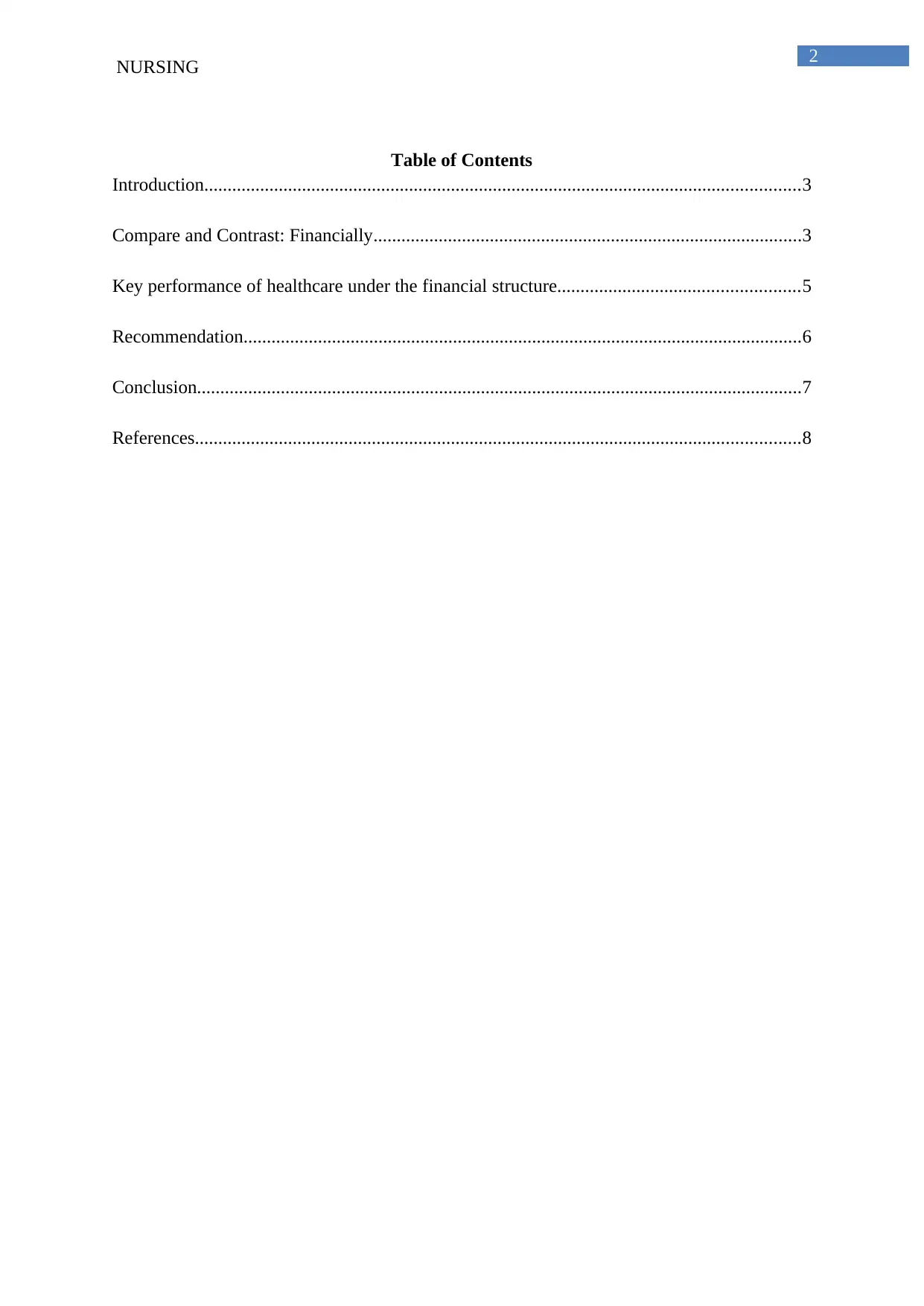
2
NURSING
Table of Contents
Introduction................................................................................................................................3
Compare and Contrast: Financially............................................................................................3
Key performance of healthcare under the financial structure....................................................5
Recommendation........................................................................................................................6
Conclusion..................................................................................................................................7
References..................................................................................................................................8
NURSING
Table of Contents
Introduction................................................................................................................................3
Compare and Contrast: Financially............................................................................................3
Key performance of healthcare under the financial structure....................................................5
Recommendation........................................................................................................................6
Conclusion..................................................................................................................................7
References..................................................................................................................................8
⊘ This is a preview!⊘
Do you want full access?
Subscribe today to unlock all pages.

Trusted by 1+ million students worldwide
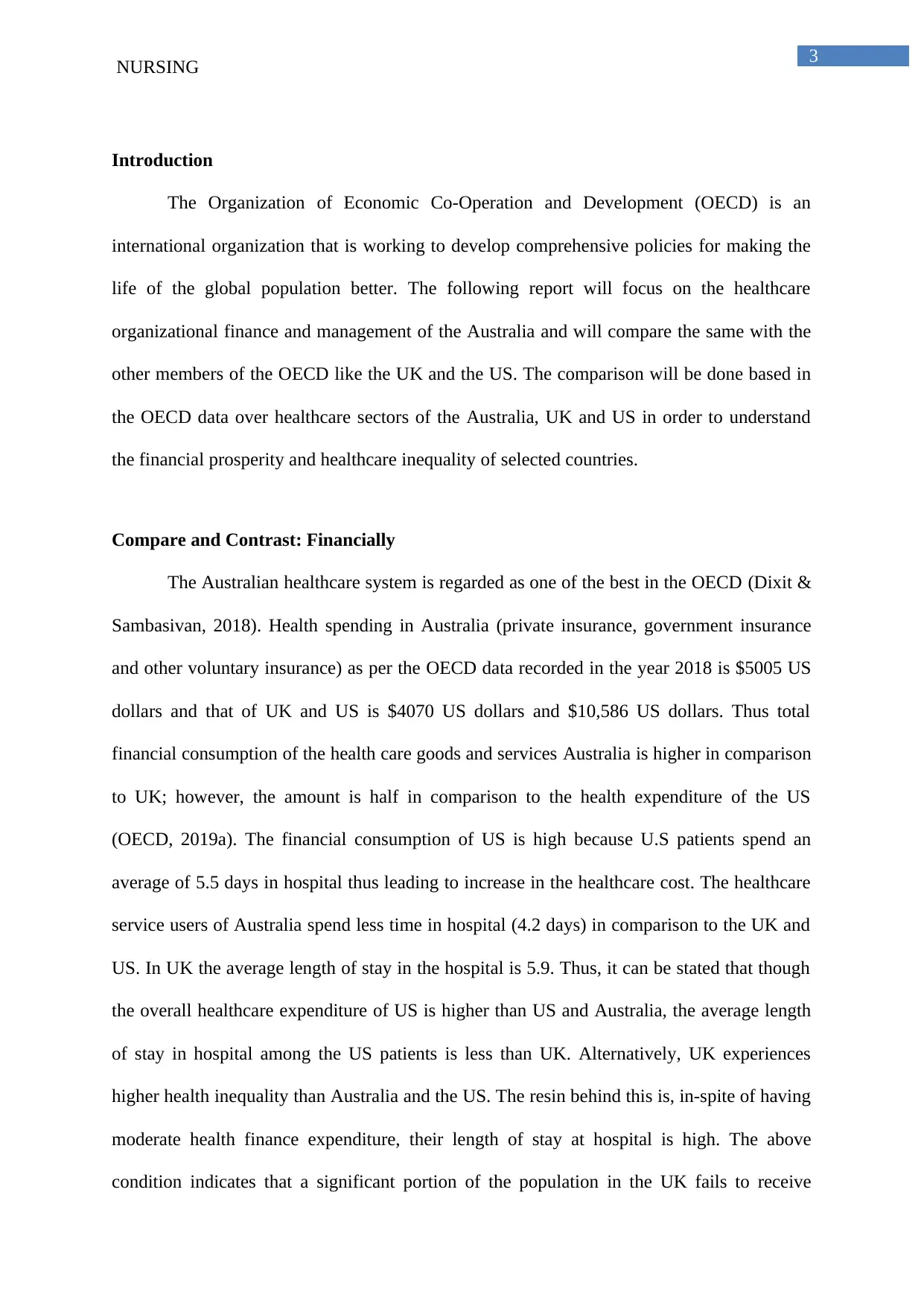
3
NURSING
Introduction
The Organization of Economic Co-Operation and Development (OECD) is an
international organization that is working to develop comprehensive policies for making the
life of the global population better. The following report will focus on the healthcare
organizational finance and management of the Australia and will compare the same with the
other members of the OECD like the UK and the US. The comparison will be done based in
the OECD data over healthcare sectors of the Australia, UK and US in order to understand
the financial prosperity and healthcare inequality of selected countries.
Compare and Contrast: Financially
The Australian healthcare system is regarded as one of the best in the OECD (Dixit &
Sambasivan, 2018). Health spending in Australia (private insurance, government insurance
and other voluntary insurance) as per the OECD data recorded in the year 2018 is $5005 US
dollars and that of UK and US is $4070 US dollars and $10,586 US dollars. Thus total
financial consumption of the health care goods and services Australia is higher in comparison
to UK; however, the amount is half in comparison to the health expenditure of the US
(OECD, 2019a). The financial consumption of US is high because U.S patients spend an
average of 5.5 days in hospital thus leading to increase in the healthcare cost. The healthcare
service users of Australia spend less time in hospital (4.2 days) in comparison to the UK and
US. In UK the average length of stay in the hospital is 5.9. Thus, it can be stated that though
the overall healthcare expenditure of US is higher than US and Australia, the average length
of stay in hospital among the US patients is less than UK. Alternatively, UK experiences
higher health inequality than Australia and the US. The resin behind this is, in-spite of having
moderate health finance expenditure, their length of stay at hospital is high. The above
condition indicates that a significant portion of the population in the UK fails to receive
NURSING
Introduction
The Organization of Economic Co-Operation and Development (OECD) is an
international organization that is working to develop comprehensive policies for making the
life of the global population better. The following report will focus on the healthcare
organizational finance and management of the Australia and will compare the same with the
other members of the OECD like the UK and the US. The comparison will be done based in
the OECD data over healthcare sectors of the Australia, UK and US in order to understand
the financial prosperity and healthcare inequality of selected countries.
Compare and Contrast: Financially
The Australian healthcare system is regarded as one of the best in the OECD (Dixit &
Sambasivan, 2018). Health spending in Australia (private insurance, government insurance
and other voluntary insurance) as per the OECD data recorded in the year 2018 is $5005 US
dollars and that of UK and US is $4070 US dollars and $10,586 US dollars. Thus total
financial consumption of the health care goods and services Australia is higher in comparison
to UK; however, the amount is half in comparison to the health expenditure of the US
(OECD, 2019a). The financial consumption of US is high because U.S patients spend an
average of 5.5 days in hospital thus leading to increase in the healthcare cost. The healthcare
service users of Australia spend less time in hospital (4.2 days) in comparison to the UK and
US. In UK the average length of stay in the hospital is 5.9. Thus, it can be stated that though
the overall healthcare expenditure of US is higher than US and Australia, the average length
of stay in hospital among the US patients is less than UK. Alternatively, UK experiences
higher health inequality than Australia and the US. The resin behind this is, in-spite of having
moderate health finance expenditure, their length of stay at hospital is high. The above
condition indicates that a significant portion of the population in the UK fails to receive
Paraphrase This Document
Need a fresh take? Get an instant paraphrase of this document with our AI Paraphraser
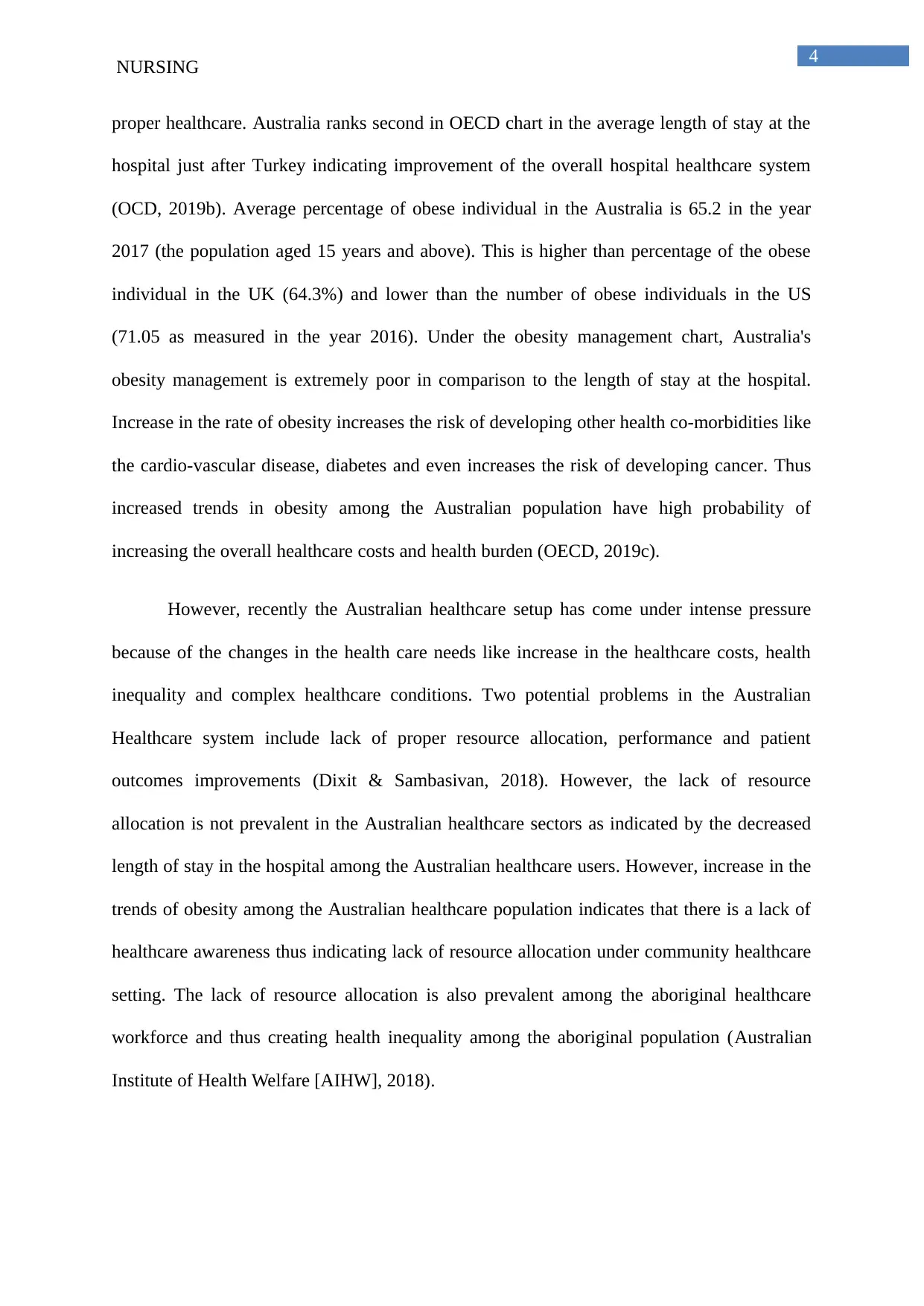
4
NURSING
proper healthcare. Australia ranks second in OECD chart in the average length of stay at the
hospital just after Turkey indicating improvement of the overall hospital healthcare system
(OCD, 2019b). Average percentage of obese individual in the Australia is 65.2 in the year
2017 (the population aged 15 years and above). This is higher than percentage of the obese
individual in the UK (64.3%) and lower than the number of obese individuals in the US
(71.05 as measured in the year 2016). Under the obesity management chart, Australia's
obesity management is extremely poor in comparison to the length of stay at the hospital.
Increase in the rate of obesity increases the risk of developing other health co-morbidities like
the cardio-vascular disease, diabetes and even increases the risk of developing cancer. Thus
increased trends in obesity among the Australian population have high probability of
increasing the overall healthcare costs and health burden (OECD, 2019c).
However, recently the Australian healthcare setup has come under intense pressure
because of the changes in the health care needs like increase in the healthcare costs, health
inequality and complex healthcare conditions. Two potential problems in the Australian
Healthcare system include lack of proper resource allocation, performance and patient
outcomes improvements (Dixit & Sambasivan, 2018). However, the lack of resource
allocation is not prevalent in the Australian healthcare sectors as indicated by the decreased
length of stay in the hospital among the Australian healthcare users. However, increase in the
trends of obesity among the Australian healthcare population indicates that there is a lack of
healthcare awareness thus indicating lack of resource allocation under community healthcare
setting. The lack of resource allocation is also prevalent among the aboriginal healthcare
workforce and thus creating health inequality among the aboriginal population (Australian
Institute of Health Welfare [AIHW], 2018).
NURSING
proper healthcare. Australia ranks second in OECD chart in the average length of stay at the
hospital just after Turkey indicating improvement of the overall hospital healthcare system
(OCD, 2019b). Average percentage of obese individual in the Australia is 65.2 in the year
2017 (the population aged 15 years and above). This is higher than percentage of the obese
individual in the UK (64.3%) and lower than the number of obese individuals in the US
(71.05 as measured in the year 2016). Under the obesity management chart, Australia's
obesity management is extremely poor in comparison to the length of stay at the hospital.
Increase in the rate of obesity increases the risk of developing other health co-morbidities like
the cardio-vascular disease, diabetes and even increases the risk of developing cancer. Thus
increased trends in obesity among the Australian population have high probability of
increasing the overall healthcare costs and health burden (OECD, 2019c).
However, recently the Australian healthcare setup has come under intense pressure
because of the changes in the health care needs like increase in the healthcare costs, health
inequality and complex healthcare conditions. Two potential problems in the Australian
Healthcare system include lack of proper resource allocation, performance and patient
outcomes improvements (Dixit & Sambasivan, 2018). However, the lack of resource
allocation is not prevalent in the Australian healthcare sectors as indicated by the decreased
length of stay in the hospital among the Australian healthcare users. However, increase in the
trends of obesity among the Australian healthcare population indicates that there is a lack of
healthcare awareness thus indicating lack of resource allocation under community healthcare
setting. The lack of resource allocation is also prevalent among the aboriginal healthcare
workforce and thus creating health inequality among the aboriginal population (Australian
Institute of Health Welfare [AIHW], 2018).
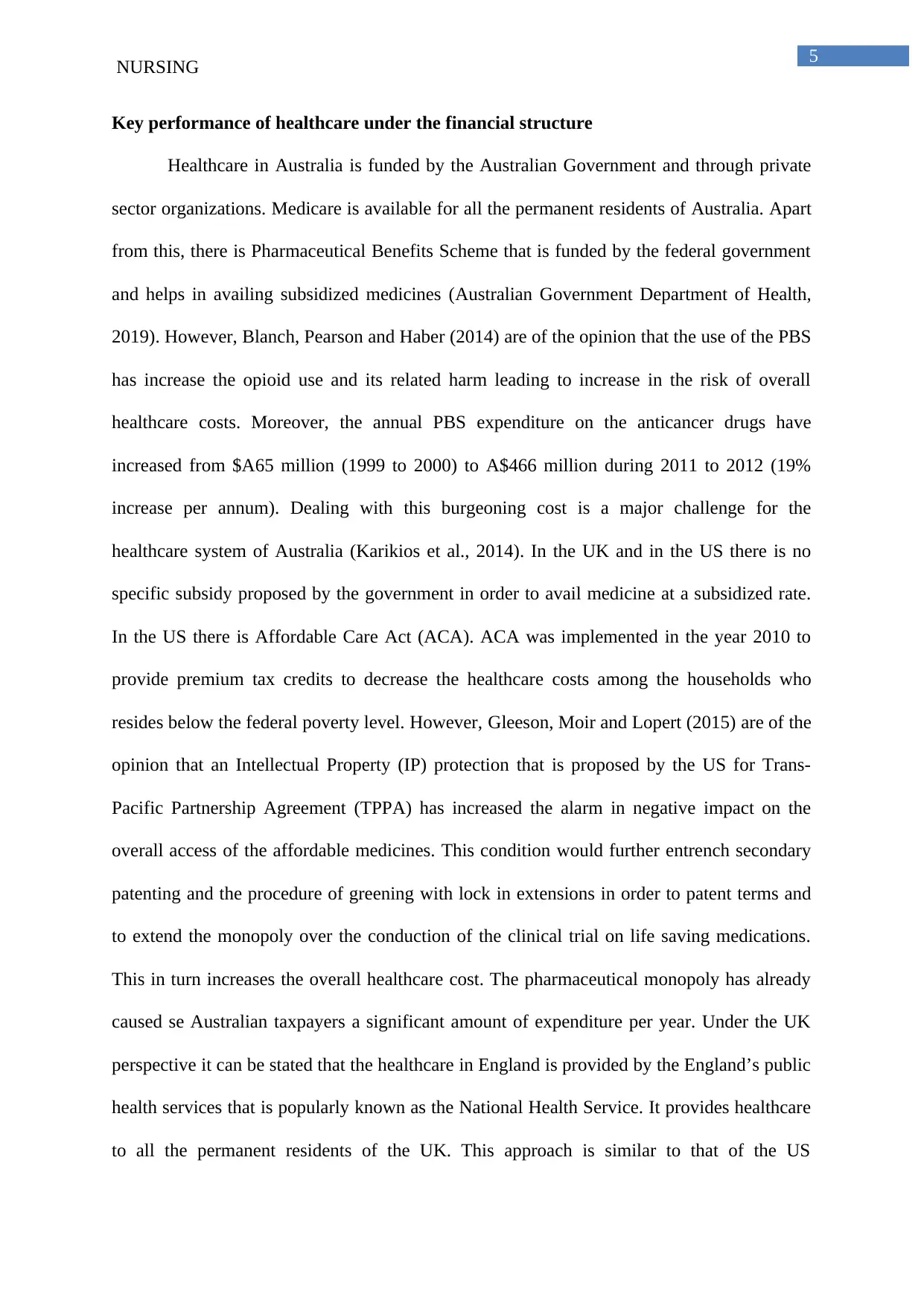
5
NURSING
Key performance of healthcare under the financial structure
Healthcare in Australia is funded by the Australian Government and through private
sector organizations. Medicare is available for all the permanent residents of Australia. Apart
from this, there is Pharmaceutical Benefits Scheme that is funded by the federal government
and helps in availing subsidized medicines (Australian Government Department of Health,
2019). However, Blanch, Pearson and Haber (2014) are of the opinion that the use of the PBS
has increase the opioid use and its related harm leading to increase in the risk of overall
healthcare costs. Moreover, the annual PBS expenditure on the anticancer drugs have
increased from $A65 million (1999 to 2000) to A$466 million during 2011 to 2012 (19%
increase per annum). Dealing with this burgeoning cost is a major challenge for the
healthcare system of Australia (Karikios et al., 2014). In the UK and in the US there is no
specific subsidy proposed by the government in order to avail medicine at a subsidized rate.
In the US there is Affordable Care Act (ACA). ACA was implemented in the year 2010 to
provide premium tax credits to decrease the healthcare costs among the households who
resides below the federal poverty level. However, Gleeson, Moir and Lopert (2015) are of the
opinion that an Intellectual Property (IP) protection that is proposed by the US for Trans-
Pacific Partnership Agreement (TPPA) has increased the alarm in negative impact on the
overall access of the affordable medicines. This condition would further entrench secondary
patenting and the procedure of greening with lock in extensions in order to patent terms and
to extend the monopoly over the conduction of the clinical trial on life saving medications.
This in turn increases the overall healthcare cost. The pharmaceutical monopoly has already
caused se Australian taxpayers a significant amount of expenditure per year. Under the UK
perspective it can be stated that the healthcare in England is provided by the England’s public
health services that is popularly known as the National Health Service. It provides healthcare
to all the permanent residents of the UK. This approach is similar to that of the US
NURSING
Key performance of healthcare under the financial structure
Healthcare in Australia is funded by the Australian Government and through private
sector organizations. Medicare is available for all the permanent residents of Australia. Apart
from this, there is Pharmaceutical Benefits Scheme that is funded by the federal government
and helps in availing subsidized medicines (Australian Government Department of Health,
2019). However, Blanch, Pearson and Haber (2014) are of the opinion that the use of the PBS
has increase the opioid use and its related harm leading to increase in the risk of overall
healthcare costs. Moreover, the annual PBS expenditure on the anticancer drugs have
increased from $A65 million (1999 to 2000) to A$466 million during 2011 to 2012 (19%
increase per annum). Dealing with this burgeoning cost is a major challenge for the
healthcare system of Australia (Karikios et al., 2014). In the UK and in the US there is no
specific subsidy proposed by the government in order to avail medicine at a subsidized rate.
In the US there is Affordable Care Act (ACA). ACA was implemented in the year 2010 to
provide premium tax credits to decrease the healthcare costs among the households who
resides below the federal poverty level. However, Gleeson, Moir and Lopert (2015) are of the
opinion that an Intellectual Property (IP) protection that is proposed by the US for Trans-
Pacific Partnership Agreement (TPPA) has increased the alarm in negative impact on the
overall access of the affordable medicines. This condition would further entrench secondary
patenting and the procedure of greening with lock in extensions in order to patent terms and
to extend the monopoly over the conduction of the clinical trial on life saving medications.
This in turn increases the overall healthcare cost. The pharmaceutical monopoly has already
caused se Australian taxpayers a significant amount of expenditure per year. Under the UK
perspective it can be stated that the healthcare in England is provided by the England’s public
health services that is popularly known as the National Health Service. It provides healthcare
to all the permanent residents of the UK. This approach is similar to that of the US
⊘ This is a preview!⊘
Do you want full access?
Subscribe today to unlock all pages.

Trusted by 1+ million students worldwide
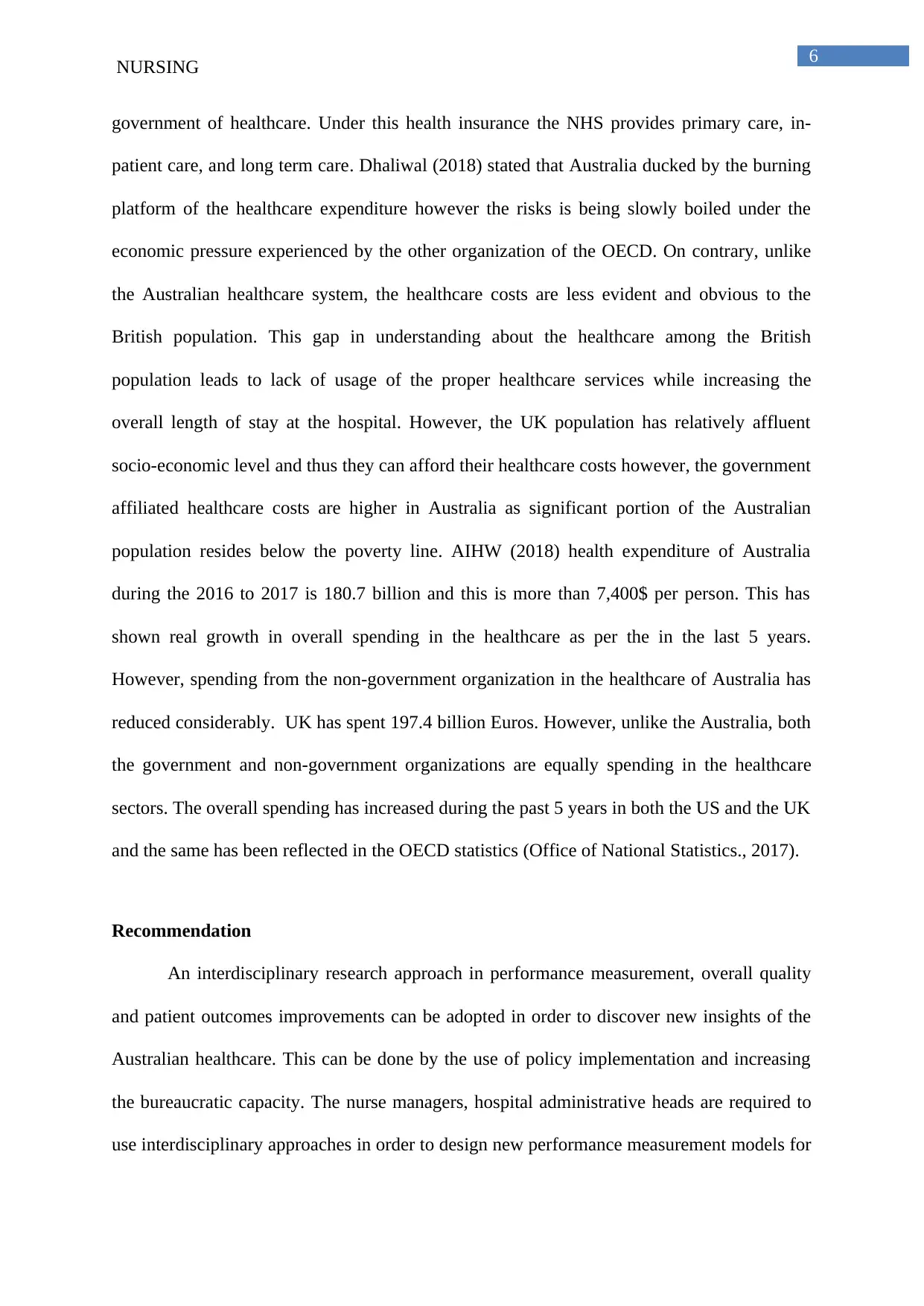
6
NURSING
government of healthcare. Under this health insurance the NHS provides primary care, in-
patient care, and long term care. Dhaliwal (2018) stated that Australia ducked by the burning
platform of the healthcare expenditure however the risks is being slowly boiled under the
economic pressure experienced by the other organization of the OECD. On contrary, unlike
the Australian healthcare system, the healthcare costs are less evident and obvious to the
British population. This gap in understanding about the healthcare among the British
population leads to lack of usage of the proper healthcare services while increasing the
overall length of stay at the hospital. However, the UK population has relatively affluent
socio-economic level and thus they can afford their healthcare costs however, the government
affiliated healthcare costs are higher in Australia as significant portion of the Australian
population resides below the poverty line. AIHW (2018) health expenditure of Australia
during the 2016 to 2017 is 180.7 billion and this is more than 7,400$ per person. This has
shown real growth in overall spending in the healthcare as per the in the last 5 years.
However, spending from the non-government organization in the healthcare of Australia has
reduced considerably. UK has spent 197.4 billion Euros. However, unlike the Australia, both
the government and non-government organizations are equally spending in the healthcare
sectors. The overall spending has increased during the past 5 years in both the US and the UK
and the same has been reflected in the OECD statistics (Office of National Statistics., 2017).
Recommendation
An interdisciplinary research approach in performance measurement, overall quality
and patient outcomes improvements can be adopted in order to discover new insights of the
Australian healthcare. This can be done by the use of policy implementation and increasing
the bureaucratic capacity. The nurse managers, hospital administrative heads are required to
use interdisciplinary approaches in order to design new performance measurement models for
NURSING
government of healthcare. Under this health insurance the NHS provides primary care, in-
patient care, and long term care. Dhaliwal (2018) stated that Australia ducked by the burning
platform of the healthcare expenditure however the risks is being slowly boiled under the
economic pressure experienced by the other organization of the OECD. On contrary, unlike
the Australian healthcare system, the healthcare costs are less evident and obvious to the
British population. This gap in understanding about the healthcare among the British
population leads to lack of usage of the proper healthcare services while increasing the
overall length of stay at the hospital. However, the UK population has relatively affluent
socio-economic level and thus they can afford their healthcare costs however, the government
affiliated healthcare costs are higher in Australia as significant portion of the Australian
population resides below the poverty line. AIHW (2018) health expenditure of Australia
during the 2016 to 2017 is 180.7 billion and this is more than 7,400$ per person. This has
shown real growth in overall spending in the healthcare as per the in the last 5 years.
However, spending from the non-government organization in the healthcare of Australia has
reduced considerably. UK has spent 197.4 billion Euros. However, unlike the Australia, both
the government and non-government organizations are equally spending in the healthcare
sectors. The overall spending has increased during the past 5 years in both the US and the UK
and the same has been reflected in the OECD statistics (Office of National Statistics., 2017).
Recommendation
An interdisciplinary research approach in performance measurement, overall quality
and patient outcomes improvements can be adopted in order to discover new insights of the
Australian healthcare. This can be done by the use of policy implementation and increasing
the bureaucratic capacity. The nurse managers, hospital administrative heads are required to
use interdisciplinary approaches in order to design new performance measurement models for
Paraphrase This Document
Need a fresh take? Get an instant paraphrase of this document with our AI Paraphraser
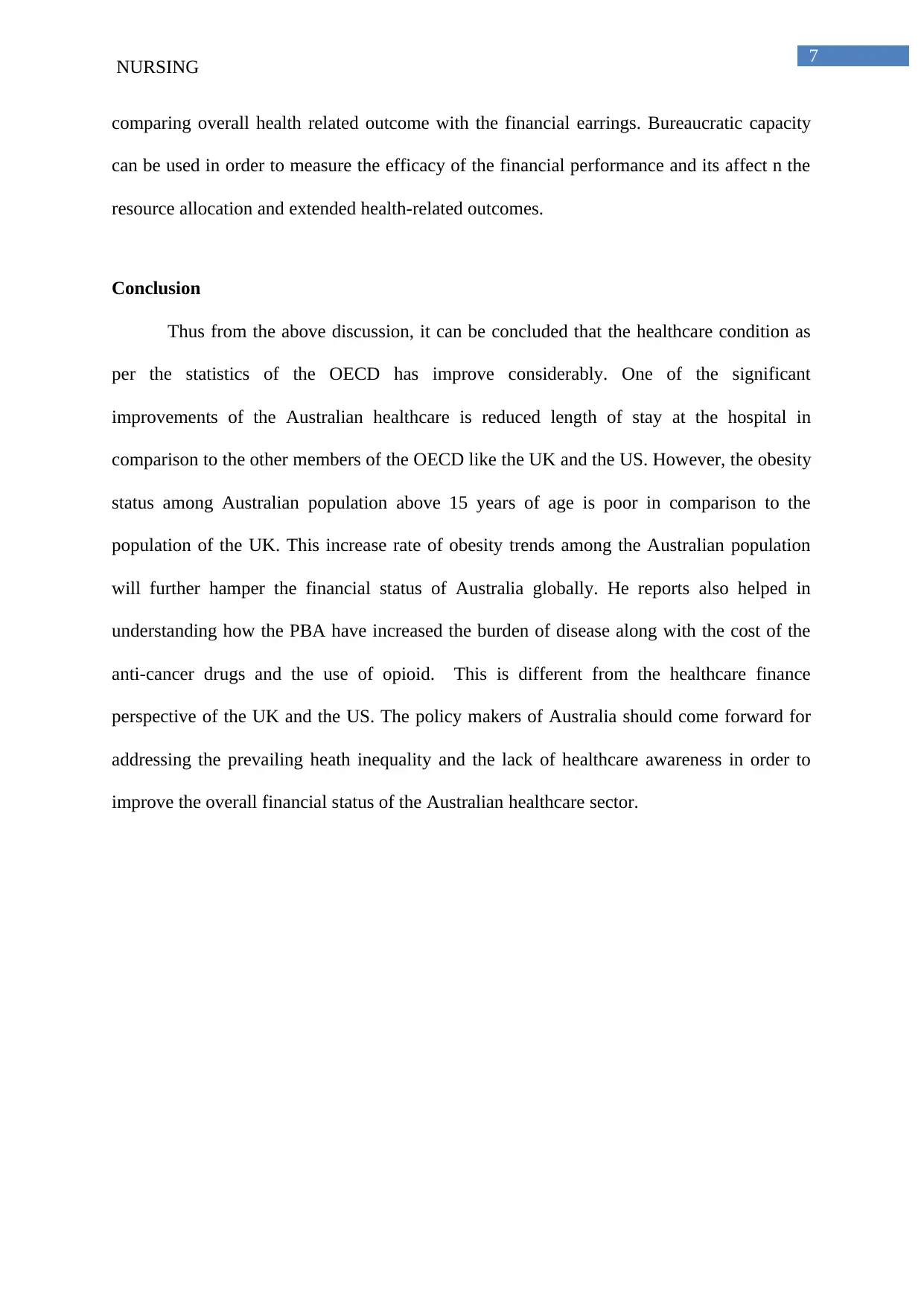
7
NURSING
comparing overall health related outcome with the financial earrings. Bureaucratic capacity
can be used in order to measure the efficacy of the financial performance and its affect n the
resource allocation and extended health-related outcomes.
Conclusion
Thus from the above discussion, it can be concluded that the healthcare condition as
per the statistics of the OECD has improve considerably. One of the significant
improvements of the Australian healthcare is reduced length of stay at the hospital in
comparison to the other members of the OECD like the UK and the US. However, the obesity
status among Australian population above 15 years of age is poor in comparison to the
population of the UK. This increase rate of obesity trends among the Australian population
will further hamper the financial status of Australia globally. He reports also helped in
understanding how the PBA have increased the burden of disease along with the cost of the
anti-cancer drugs and the use of opioid. This is different from the healthcare finance
perspective of the UK and the US. The policy makers of Australia should come forward for
addressing the prevailing heath inequality and the lack of healthcare awareness in order to
improve the overall financial status of the Australian healthcare sector.
NURSING
comparing overall health related outcome with the financial earrings. Bureaucratic capacity
can be used in order to measure the efficacy of the financial performance and its affect n the
resource allocation and extended health-related outcomes.
Conclusion
Thus from the above discussion, it can be concluded that the healthcare condition as
per the statistics of the OECD has improve considerably. One of the significant
improvements of the Australian healthcare is reduced length of stay at the hospital in
comparison to the other members of the OECD like the UK and the US. However, the obesity
status among Australian population above 15 years of age is poor in comparison to the
population of the UK. This increase rate of obesity trends among the Australian population
will further hamper the financial status of Australia globally. He reports also helped in
understanding how the PBA have increased the burden of disease along with the cost of the
anti-cancer drugs and the use of opioid. This is different from the healthcare finance
perspective of the UK and the US. The policy makers of Australia should come forward for
addressing the prevailing heath inequality and the lack of healthcare awareness in order to
improve the overall financial status of the Australian healthcare sector.
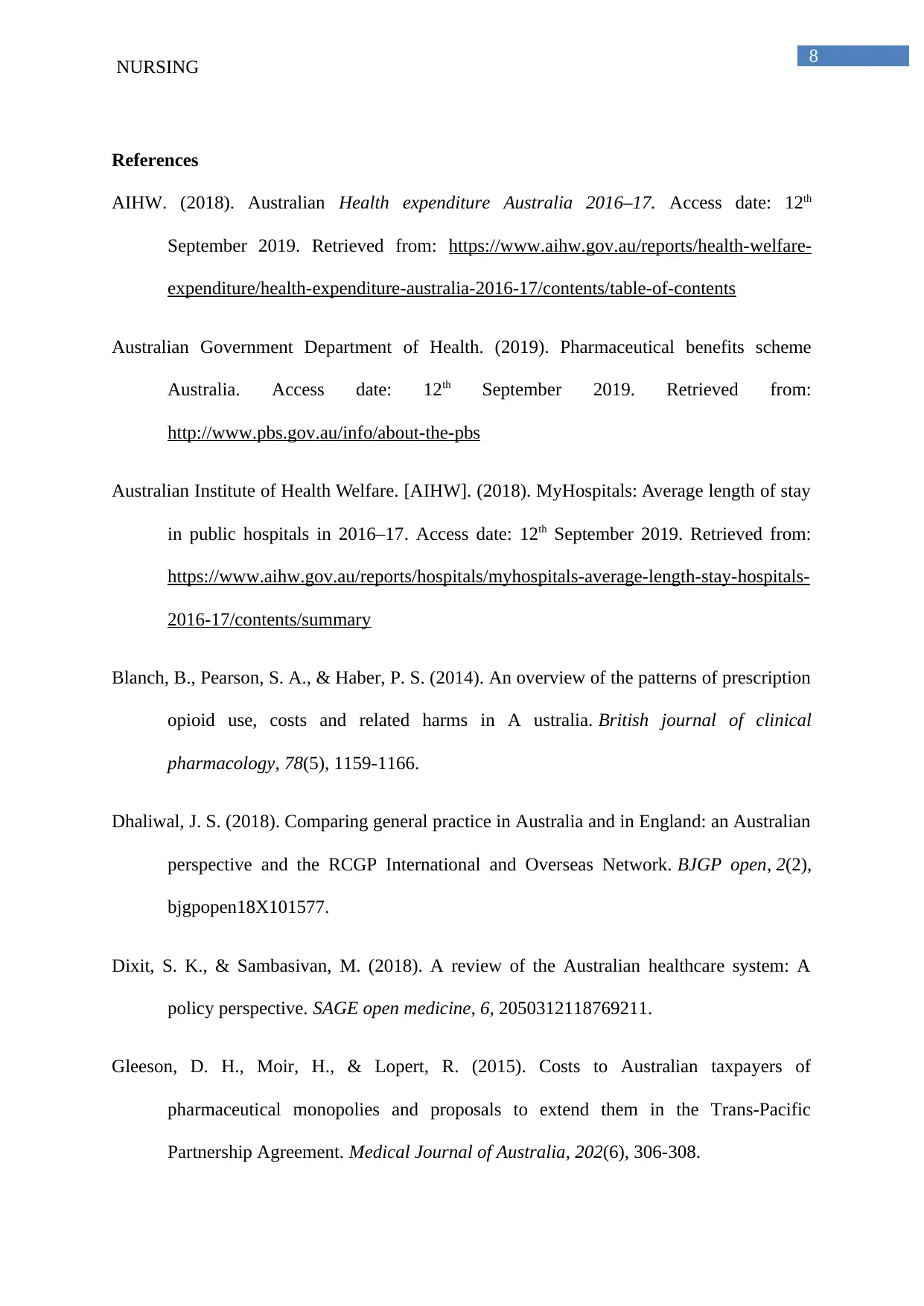
8
NURSING
References
AIHW. (2018). Australian Health expenditure Australia 2016–17. Access date: 12th
September 2019. Retrieved from: https://www.aihw.gov.au/reports/health-welfare-
expenditure/health-expenditure-australia-2016-17/contents/table-of-contents
Australian Government Department of Health. (2019). Pharmaceutical benefits scheme
Australia. Access date: 12th September 2019. Retrieved from:
http://www.pbs.gov.au/info/about-the-pbs
Australian Institute of Health Welfare. [AIHW]. (2018). MyHospitals: Average length of stay
in public hospitals in 2016–17. Access date: 12th September 2019. Retrieved from:
https://www.aihw.gov.au/reports/hospitals/myhospitals-average-length-stay-hospitals-
2016-17/contents/summary
Blanch, B., Pearson, S. A., & Haber, P. S. (2014). An overview of the patterns of prescription
opioid use, costs and related harms in A ustralia. British journal of clinical
pharmacology, 78(5), 1159-1166.
Dhaliwal, J. S. (2018). Comparing general practice in Australia and in England: an Australian
perspective and the RCGP International and Overseas Network. BJGP open, 2(2),
bjgpopen18X101577.
Dixit, S. K., & Sambasivan, M. (2018). A review of the Australian healthcare system: A
policy perspective. SAGE open medicine, 6, 2050312118769211.
Gleeson, D. H., Moir, H., & Lopert, R. (2015). Costs to Australian taxpayers of
pharmaceutical monopolies and proposals to extend them in the Trans‐Pacific
Partnership Agreement. Medical Journal of Australia, 202(6), 306-308.
NURSING
References
AIHW. (2018). Australian Health expenditure Australia 2016–17. Access date: 12th
September 2019. Retrieved from: https://www.aihw.gov.au/reports/health-welfare-
expenditure/health-expenditure-australia-2016-17/contents/table-of-contents
Australian Government Department of Health. (2019). Pharmaceutical benefits scheme
Australia. Access date: 12th September 2019. Retrieved from:
http://www.pbs.gov.au/info/about-the-pbs
Australian Institute of Health Welfare. [AIHW]. (2018). MyHospitals: Average length of stay
in public hospitals in 2016–17. Access date: 12th September 2019. Retrieved from:
https://www.aihw.gov.au/reports/hospitals/myhospitals-average-length-stay-hospitals-
2016-17/contents/summary
Blanch, B., Pearson, S. A., & Haber, P. S. (2014). An overview of the patterns of prescription
opioid use, costs and related harms in A ustralia. British journal of clinical
pharmacology, 78(5), 1159-1166.
Dhaliwal, J. S. (2018). Comparing general practice in Australia and in England: an Australian
perspective and the RCGP International and Overseas Network. BJGP open, 2(2),
bjgpopen18X101577.
Dixit, S. K., & Sambasivan, M. (2018). A review of the Australian healthcare system: A
policy perspective. SAGE open medicine, 6, 2050312118769211.
Gleeson, D. H., Moir, H., & Lopert, R. (2015). Costs to Australian taxpayers of
pharmaceutical monopolies and proposals to extend them in the Trans‐Pacific
Partnership Agreement. Medical Journal of Australia, 202(6), 306-308.
⊘ This is a preview!⊘
Do you want full access?
Subscribe today to unlock all pages.

Trusted by 1+ million students worldwide
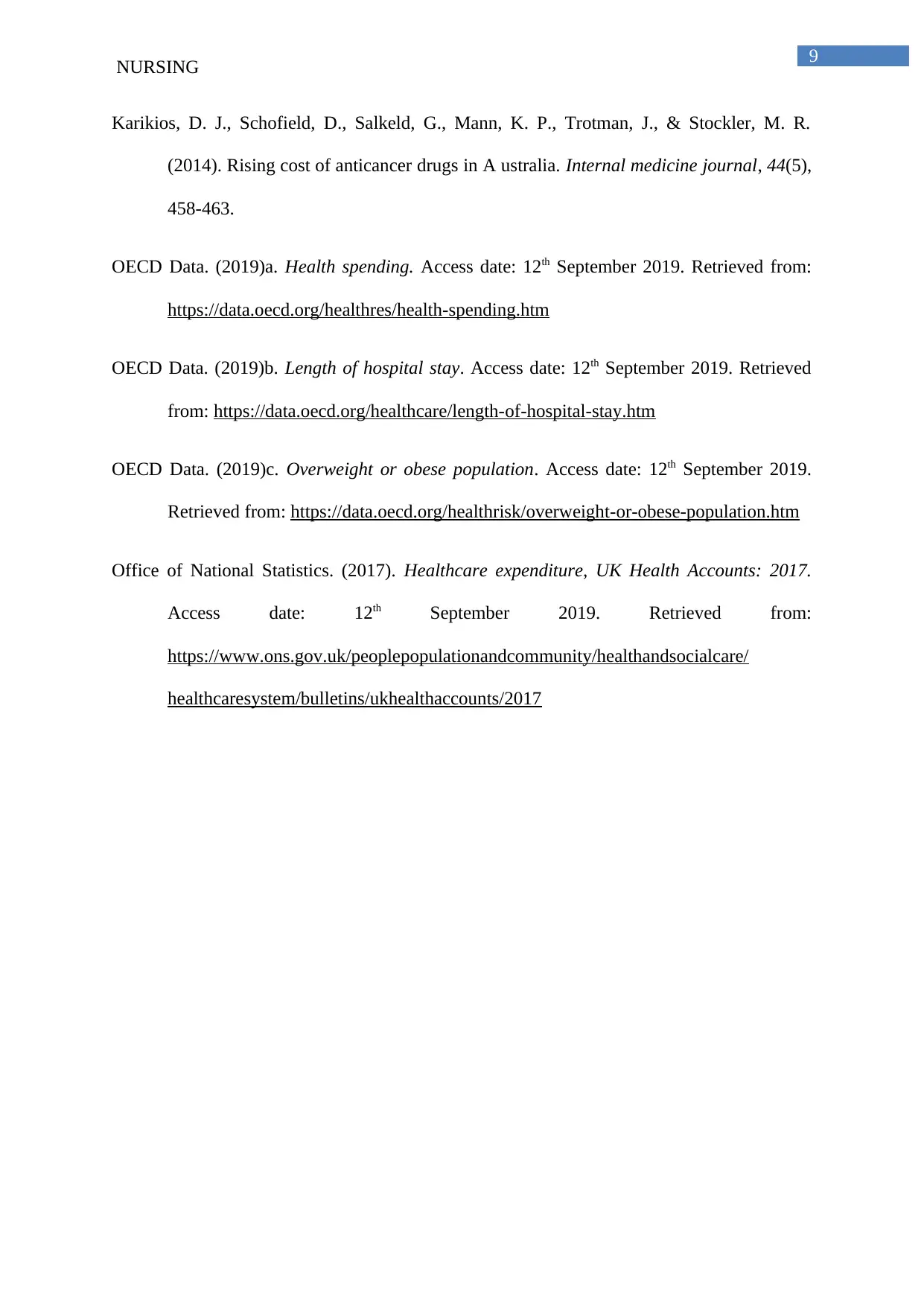
9
NURSING
Karikios, D. J., Schofield, D., Salkeld, G., Mann, K. P., Trotman, J., & Stockler, M. R.
(2014). Rising cost of anticancer drugs in A ustralia. Internal medicine journal, 44(5),
458-463.
OECD Data. (2019)a. Health spending. Access date: 12th September 2019. Retrieved from:
https://data.oecd.org/healthres/health-spending.htm
OECD Data. (2019)b. Length of hospital stay. Access date: 12th September 2019. Retrieved
from: https://data.oecd.org/healthcare/length-of-hospital-stay.htm
OECD Data. (2019)c. Overweight or obese population. Access date: 12th September 2019.
Retrieved from: https://data.oecd.org/healthrisk/overweight-or-obese-population.htm
Office of National Statistics. (2017). Healthcare expenditure, UK Health Accounts: 2017.
Access date: 12th September 2019. Retrieved from:
https://www.ons.gov.uk/peoplepopulationandcommunity/healthandsocialcare/
healthcaresystem/bulletins/ukhealthaccounts/2017
NURSING
Karikios, D. J., Schofield, D., Salkeld, G., Mann, K. P., Trotman, J., & Stockler, M. R.
(2014). Rising cost of anticancer drugs in A ustralia. Internal medicine journal, 44(5),
458-463.
OECD Data. (2019)a. Health spending. Access date: 12th September 2019. Retrieved from:
https://data.oecd.org/healthres/health-spending.htm
OECD Data. (2019)b. Length of hospital stay. Access date: 12th September 2019. Retrieved
from: https://data.oecd.org/healthcare/length-of-hospital-stay.htm
OECD Data. (2019)c. Overweight or obese population. Access date: 12th September 2019.
Retrieved from: https://data.oecd.org/healthrisk/overweight-or-obese-population.htm
Office of National Statistics. (2017). Healthcare expenditure, UK Health Accounts: 2017.
Access date: 12th September 2019. Retrieved from:
https://www.ons.gov.uk/peoplepopulationandcommunity/healthandsocialcare/
healthcaresystem/bulletins/ukhealthaccounts/2017
1 out of 10
Related Documents
Your All-in-One AI-Powered Toolkit for Academic Success.
+13062052269
info@desklib.com
Available 24*7 on WhatsApp / Email
![[object Object]](/_next/static/media/star-bottom.7253800d.svg)
Unlock your academic potential
Copyright © 2020–2025 A2Z Services. All Rights Reserved. Developed and managed by ZUCOL.





